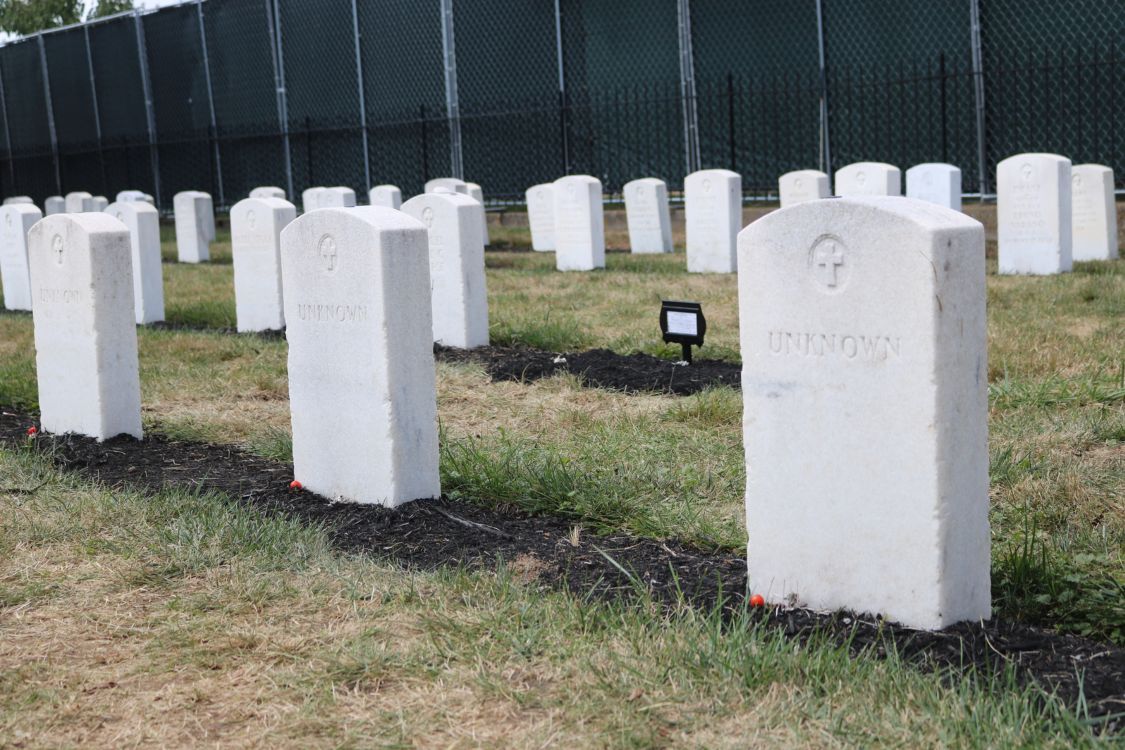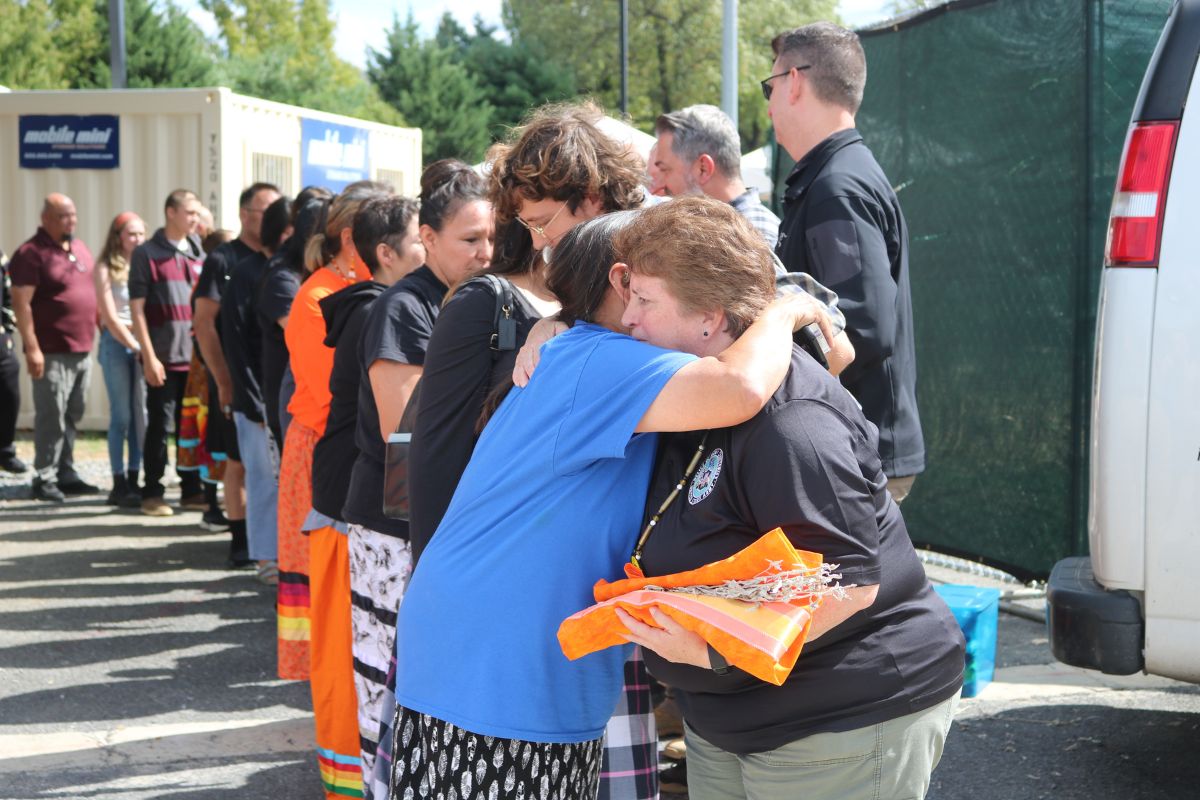![The Fort Belknap Indian Community Repatriation Delegation in Carlisle, Pennsylvania the week of Sept. 18. “Maybe we're the first tribe that [the Army] isn’t giving a hard time to,” said deputy tribal historic preservation office, (left) Emma Filesteel. (Photo: Jenna Kunze) From back left: Tribal chairman Jeffrey Stiffarm, Tribal historic preservation officer Michael Blackwolf, Gros Ventre Council representative Geno LaValdo, Assiniboine Council representative and boarding school survivor Donovan Archambault.](/images/2022/The_Fort_Belknap_Indian_Community_Repatriation_Delegation.png)
- Details
- By Jenna Kunze
Carlisle, Penn. — Tribal nations seeking the return of their children buried at what was once the nation’s flagship Indigenous assimilation institution, the Carlisle Indian Industrial School, may have a new playbook to follow—one that involves the U.S. Army’s cooperation.
For the first time, the Army this summer granted the requests of three tribal nations to visit the Carlisle Barracks Post Cemetery—now the site of the U.S. Army War College – to plan for the return of their respective children who were among the nearly 200 who died and were buried while students at the Carlisle Indian Industrial School.
Last week, delegates from The Fort Belknap Indian Community of north-central Montana and The Cheyenne and Arapaho Tribes of Concho, Oklahoma, were on the ground at Carlisle.
The site visits allowed for the tribes to gather information about their relatives and preview the process of unearthing, identifying, and returning their relatives, some as soon as next summer.
“It was very important for us as a tribal delegation to actually be on the ground out there,” Deputy Tribal Historic Preservation Office for the Fort Belknap tribe, Emma Filestell, told Native News Online.
The tribe is expecting to bring home four relatives—including one buried under an “unknown” headstone—next year.
“They actually showed us what the process was with the forensic [analysis]. It was good for us to see what to expect, and what we’re going to have to go through next year,” Filestell said.
During the Fort Belknap delegation’s five-day visit to Pennsylvania, which was paid for by the tribe, the Army organized tribal visits to: the Cumberland Valley Historical Society, which holds historic documents tied to the school, and Dickinson College’s Carlisle Indian School Digital Resource Center, a local project where archivists have spent the last ten years digitizing U.S. National Archives related to the school.
"This is the first year that Army Cemeteries has reached out to me and the CISDRC as a resource to help families and tribal representatives learn more about the available documentation that we’ve identified and digitized to date," Carlisle Indian School Digital Research Center archivist Jim Gerencser told Native News Online.
The tribe was also invited to tour the cemetery at Carlisle and meet with the archeologists and forensic anthropologists to illuminate the process of disinterment for next summer.
 The number of unidentified Native children buried under ‘Unknown’ headstones has grown nearly every year since the Army began disintering and returning ancestors to their tribal nations. (Photo:Jenna Kunze)
The number of unidentified Native children buried under ‘Unknown’ headstones has grown nearly every year since the Army began disintering and returning ancestors to their tribal nations. (Photo:Jenna Kunze)
“Expecting resistance”
Since 2017, the Army has disinterred and returned a total of 32 children to their tribal nations for reburial, but not without significant criticism on what many tribal nations called an unnecessarily difficult process.
Tribal nations have struggled with unclear deadlines, Army policy that ignores tribal sovereignty and requires tribes to research and send their childrens’ “closest living relative” to Carlisle to collect their retrieve, and past government mistakes that have led to several mix-ups and complications in identifying and returning children.
Most recently, this past March, the Sisseton Wahpeton Oyate pressured the Army with legal action after the Army reneged on its agreement to return their ancestor this summer.
As a result of the tribe’s letter, two Oyate boys were the final children to go home in the 2023 disinterment project, which ended last week.
But in preparing for next year’s disinterment, Fort Belknap representatives said it already seems that the Army is beginning to “see the light” when it comes to tribal involvement and allowing tribes to determine familial relationships themselves.
The Army allowed for Fort Belknap Indian Community President Jeff Stiffarm to claim all four of the tribe's relatives—including one buried under an ‘UNKNOWN’ headstone, and his own relative, Almeda Heavyhair— whereas in the past they’ve required individual affidavit signatures from the “closest living relative” of each child.
“Honestly, I was expecting a little more resistance [from the Army], and I was pleasantly surprised that they were rolling out the red carpet and bending over backward for us,” Mike Blackwolf, the tribal historic preservation officer for Fort Belknap, told Native News Online. “They were like: ‘If you guys want them, we’re going to send them home.’”
That change allows for Fort Belknap to lock in their spot in next summer’s disinterment roster while also giving them a year to notify and research any living descendants their children might have, and decide themselves who will travel across the country next summer to retrieve their children.
“Some of these children may not have any living descendants left, but that doesn't make them any less ours, and it doesn't make us not want them back home any less,” Blackwolf said. “Whatever happened with the previous couple repatriations, I‘m sure that's what made the Army see the light that that policy was ridiculous. Regardless if there are any living descendants left, we want them home because they are our people.”
Additionally, Cheyenne and Arapaho tribal historic preservation officer Max Bear told Native News Online that his tribe also plans to file their paperwork with the Army by February to claim 15 of their children—including one unknown—next summer.
“We are trying to find the descendants of these children and see if they want to be a part of [the disinterment], and if not then the tribe will sign off on a blanket affidavit to go ahead and do the disinterment,” Bear said. “There may not be any descendants left.”
In a written response to Native News Online, representatives from the Office of Army Cemeteries said that it has “from the beginning of this program, accepted the affidavits as submitted,” and that it “recognize[s] and respect[s] traditional tribal knowledge as to the relationships of persons within Tribes.”
While Sisseton Oyate tribal historian Tamara St. John, who spent the last seven years working the Army to return her tribe’s children, said that she loves that the Army is being more lenient, she thinks they need to change their written policy away from military language, to allow for tribes to claim their relatives.
“It's not appropriate to put that on a Native American child from the 1800s,” she said. “Why do we have to bear the burden of finding some solution to these policies or problems that result from the lack of care or record keeping?”
 Office of Army Cemeteries Director Renea Yates (right) hugs a Sisseton Wahpeton Oyate tribal elder last week at the transfer ceremony of two Oyate boys last week. “These are people I feel to my core are our allies,” Tamara St. John said of the Army staff who worked on the disinterment, including Yates. “They care, they really do. I have to be fair in telling that, as well.” (Photo: Jenna Kunze)
Office of Army Cemeteries Director Renea Yates (right) hugs a Sisseton Wahpeton Oyate tribal elder last week at the transfer ceremony of two Oyate boys last week. “These are people I feel to my core are our allies,” Tamara St. John said of the Army staff who worked on the disinterment, including Yates. “They care, they really do. I have to be fair in telling that, as well.” (Photo: Jenna Kunze)
Looking ahead
According to the Office of Army Cemeteries Director Renea Yates, ten to twelve children are scheduled to go home from Carlisle in 2024, though the final number won’t be confirmed and published in the federal register until about four months ahead of the project.
Currently, there are more than 160 children that still remain buried at Carlisle. The Army has returned about seven to ten a year, costing between $600,000 and $700,000 each year, Yates told Native News Online.
If the Army continues at its current pace, and every tribe claims its ancestors at Carlisle, it will take a minimum of another 16 years and $96 million dollars before each relative is returned.
But each year, tribes are getting better at navigating the process alongside the Army by learning from the tribes who came before them, St. John said.
“The [next tribes] have been observing, listening, and watching us for six years. They're coming behind us, but just as we were made stronger by Rosebud, they’re being made stronger by us.”
The Army said it will continue to offer site visits to interested tribes upon request. Tribes can contact the Office of Army Cemeteries at: [email protected].
More Stories Like This
50 Years of Self-Determination: How a Landmark Act Empowered Tribal Sovereignty and Transformed Federal-Tribal RelationsCherokee Nation Launches Digital Dictionary to Support Language Revitalization
Prairie Band Potawatomi Nation Chairman Addresses Homeland Security Contract
Lancaster County to Recognize Conestoga-Susquehannock Tribe on Massacre Anniversary
How the Gaming Economy Helps Tribes Navigate Shifting Policies
Help us defend tribal sovereignty.
At Native News Online, our mission is rooted in telling the stories that strengthen sovereignty and uplift Indigenous voices — not just at year’s end, but every single day.
Because of your generosity last year, we were able to keep our reporters on the ground in tribal communities, at national gatherings and in the halls of Congress — covering the issues that matter most to Indian Country: sovereignty, culture, education, health and economic opportunity.
That support sustained us through a tough year in 2025. Now, as we look to the year ahead, we need your help right now to ensure warrior journalism remains strong — reporting that defends tribal sovereignty, amplifies Native truth, and holds power accountable.
 The stakes couldn't be higher. Your support keeps Native voices heard, Native stories told and Native sovereignty defended.
The stakes couldn't be higher. Your support keeps Native voices heard, Native stories told and Native sovereignty defended.
Stand with Warrior Journalism today.
Levi Rickert (Potawatomi), Editor & Publisher


